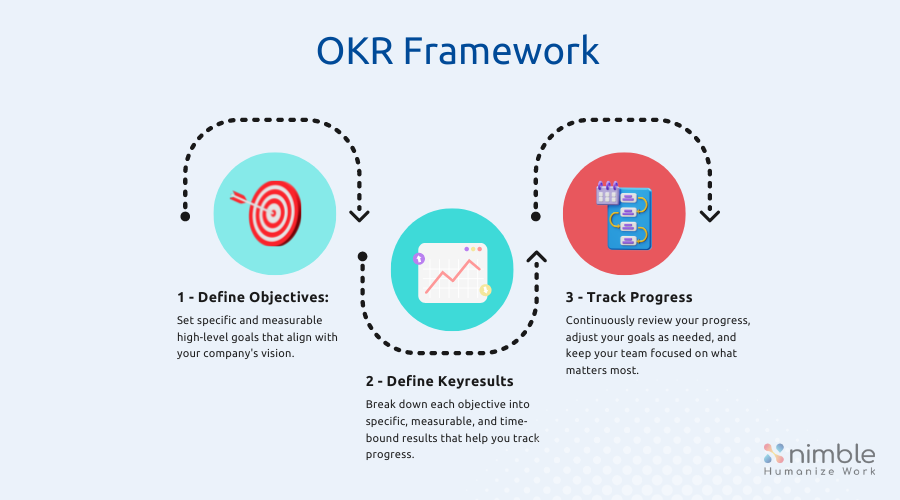OKRs vs. KPIs: Navigating the Metrics Maze – Differences, Examples, and Real-World Applications
Explore OKRs vs. KPIs: Uncover differences, examples, and real-world insights. Elevate your goal-setting and performance measurement strategies.
_____________________
_____________________
 By
Carlos Schults
By
Carlos Schults
To make a team or organization efficient and agile, you need a motivated workforce. But to ensure you’re putting your effort where it needs to be-a.k.a “building the right thing”- you need alignment.
That’s why goal setting is so vital within an organization. Goals help everyone stay on the same page. They create focus and foster a shared purpose.
Implementing OKRs can be a great way for organizations to create organization-wide goals that keep motivation and alignment high, and in this post, you’ll learn more about this framework.
According to Wikipedia, OKR is “[…] a goal-setting framework used by individuals, teams, and organizations to define measurable goals and track their outcomes. The development of OKR is generally attributed to Andrew Grove who introduced the approach to Intel in the 1970s.”
OKR isn’t the only goal-setting framework at the disposal of organizations. Other frameworks exist, such as KPIs—key performance indicators— and KRAs—key result areas. A detailed discussion of these frameworks is out of the scope of this article, but here’s a short overview:
OKR stands for Objective and Key Results. As you’ve seen from Wikipedia’s definition, the OKR is a framework that people and organizations use to create and track goals in a measurable way.

The history of the ORK framework goes back to Intel in the 1970s. Andrew Grove, during his tenure as CEO, popularized the concept of ORKs, building upon previous work from Peter Drucker. In 1975, while at Intel, John Doerr acquired the OKR concept from Grove. Fast forward to 1999, and Doerr introduced this framework to Google.
You’ll learn more details about the workings of ORKs—the “how”—in a minute. For now, let’s focus on the “why.” Why do organizations adopt the ORK framework? What are the motivations?
Here’s an overview of the main benefits:
• Focus and alignment: OKRs help all levels of the organization rally behind the same objectives, generating focus and making sure resources aren’t wasted on unimportant things.
• Accountability: OKRs help teams define and track measurable goals, fostering a sense of purpose and accountability.
• Motivation: One of the key tenets of the ORK framework is the idea of stretch goals—i.e. setting audacious goals that are a bit beyond what’s realistic or feasible, in order to motivate the workforce.
• Adaptation: Organizations usually set OKRs for a specific period. That means you can—and should—periodically reevaluate your OKRs, which enables you to stay up-to-date with the business needs of the organization.
Let’s now dive a bit deeper into the workings of the OKR framework. Let’s start by defining the “O” in OKR: the objective.
An objective in OKR is a high-level goal, defined for the whole organization. The objective, simply put, is what you want to achieve. It should be concrete, clearly defined, yet aspirational.
Here are some examples of OKR objectives:
• Increase the conversation rate of our virtual store.
• Improve the customer satisfaction of our main app.
• Increase our market share.
• Skyrocket the stability of our services.
In OKR, each objective is accompanied by a few—usually from 3 to 5—key results.
While the objective is the high-level goal, the key results are the specific measurable steps that will be taken toward the objective.
When defining key results, there are a few points you must be mindful of. First, key results should be defined in such a way that there’s no room for doubt whether you’ve achieved them or not. That’s why KRs must be stated in measurable terms, such as percentages or monetary values.
Great KRs are also time-bound. The business world is competitive and always changing. So, if they are to remain relevant, KRs should be attached to a specific timeframe.
In tracking OKR goals, Nimble’s OKRs feature plays a pivotal role. By seamlessly integrating OKRs into the project management workflow, Nimble enables teams to set, track, and measure key results alongside project tasks. With customizable dashboards and progress-tracking tools, Nimble ensures alignment between OKR goals and project execution, empowering teams to achieve their objectives efficiently and effectively.
Let’s see some examples of key results. Considering the first objective from the previous section, I’ll list three possible KRs:
• Improve the performance of the front page by reducing the TTFB metric in 15% by the next two months.
• Reduce bounce rate by 10% within the next quarter.
• Conduct A/B testing on the checkout process to implement changes that result in a 10% increase in conversion rate within two months.
Let’s now briefly cover the concept of SMART goals. By the end of the section, the reader will understand why this topic matters to the discussion at hand and forgive me for the digression.
We’ve already covered SMART goals before, but if you haven’t read that article, we’ll give you a fresh overview.
SMART is a way to define goals that you’re actually likely to track and accomplish. There are several, slightly different versions of the acronym. It seems that the one most widely accepted nowadays is Specific, Measurable, Achievable, Relevant, and Timed.
In other words, SMART goals:
• are specific instead of ambiguously defined
• can be measurable in an objective way
• can be aggressive but must be achievable
• are relevant for the individual or organization
• and are time-bound, since few goals stay relevant forever
How do SMART goals relate to ORKs? At first, they’re orthogonal: you don’t need to implement OKRs in order to use SMART goals, or vice-versa.
However, SMART goals can certainly be used as a guideline when setting the key results for an OKR. As you’ve seen, KRs should be specific, measurable, and time-bound, and it goes without saying that they should be relevant.
The only point where SMART goals can deviate from KRs is regarding the letter “A”. An important tenet of OKR is the concept of stretch goals: that is, in order to motivate people inside your organization, you should define goals that go just beyond what’s realistic. When doing so—so the theory goes—people will often go beyond what they think it’s possible, achieving better results than they would otherwise.
Before departing, let’s answer a final question: what are goals in OKR?
As you’ve seen, in OKR you have two main concepts: an objective, which is supported by a few key results.
Formally speaking, we don’t have the concept of goals in OKRs, at leat not nominally. Of course, both the objective and its key results can be considered goals: while the former is the high-level, aspirational goal, the latter are the specific measurable goals—or targets—you want to achieve in order to accomplish the larger goal.
We all know how competitive business can be. To survive—and thrive—organizations need to be fast and efficient. But speed and efficiency are terrible if they’re at the service of building the wrong product or service.
Thus, goal-setting is a crucial activity for organizations—and, for what’s worth, in our personal lives as well. It’s through the use of clearly defined goals that organizations can create alignment, a sense of purpose, and the motivation that they need to ensure they’re doing the right thing, the right way.
There are many competing frameworks for goal-setting. In this post, you’ve learned about one of the most popular ones: the OKR framework. By setting aspirational high-level goals, backed up by measurable, specific, and ambitious key results, you can help your organization achieve the focus, alignment, accountability, and agility it needs to thrive and grow.
Since you’ve just learned more about the OKR framework, you might be wondering what your next steps should be. A suggestion is to explore the tools at your disposal, such as Nimble OKR, a powerful and flexible platform that can help your organization implement OKRs.

OKRs 101
OKRs vs. KPIs: Navigating the Metrics Maze – Differences, Examples, and Real-World Applications
Explore OKRs vs. KPIs: Uncover differences, examples, and real-world insights. Elevate your goal-setting and performance measurement strategies.
What is an OKR goal? What is an OKR objective?
Implementing OKRs can be a great way for organizations to create organization-wide goals that keep motivation and alignment high, and in this post, you’ll learn more about this framework.
Tracking OKRs: Where the Real OKR Magic Happens
Implementing OKRs: 11 Do’s and 8 Don’ts for OKR Success
OKR Implementation Guide: 8 Tips to Ace Your OKRs
OKR Targets and Psychological Safety: At Odds or a Match Made in Heaven
SMART Goals or OKRs Targets for Motivational Power?
Join 150,000+ Pioneers, Leaders & Mavericks receiving our updates!

